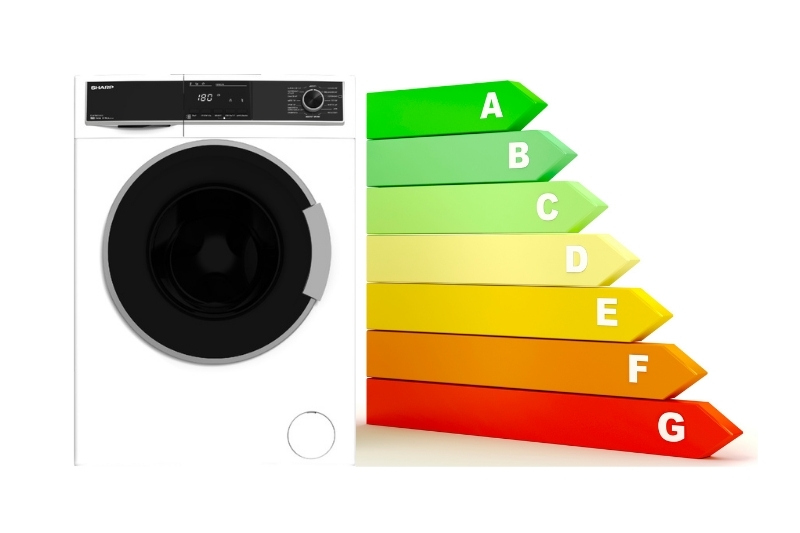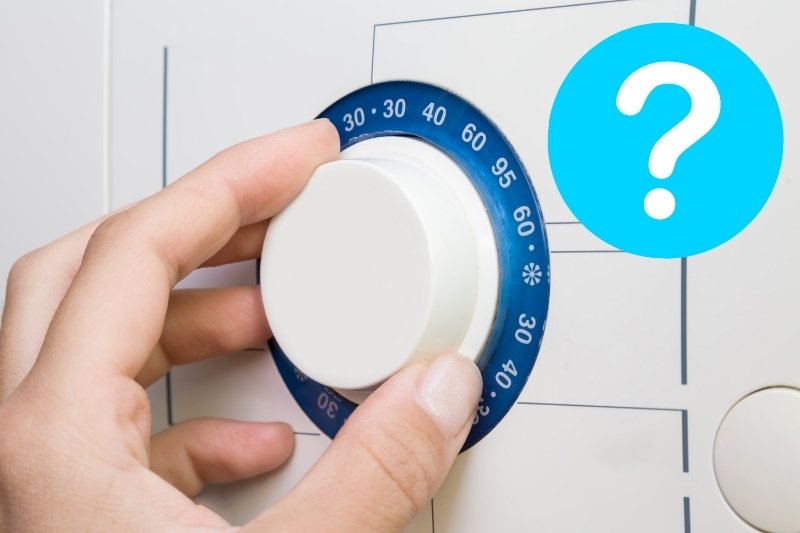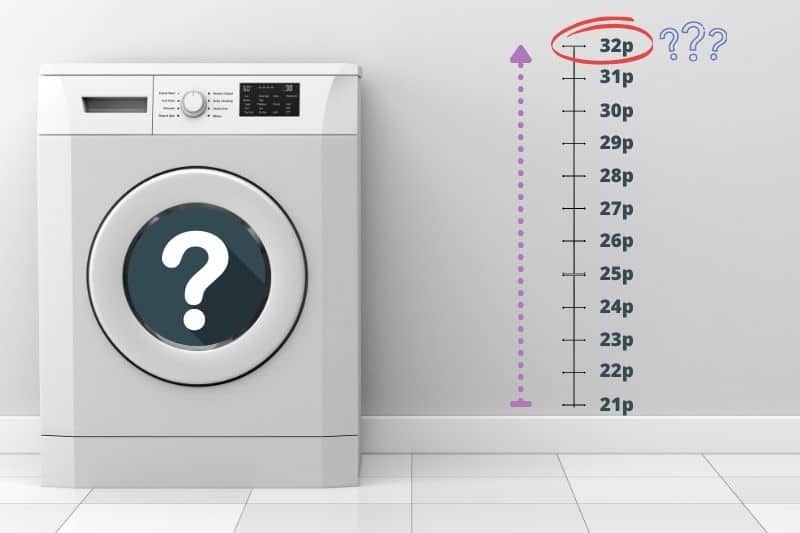Most of us use the washing machine several times a week, but how much does it cost, and how can you save money when washing clothes?
We looked at 20 of the most popular washing machines in the UK to calculate the average amount of electricity and water used per cycle. You can find the data in the table below.
We then worked out the average running costs based on current electricity and water prices for April to June 2025.
Read on to find out how much your washing machine costs to run!
Electricity Costs
Let’s look at electricity usage first, since this is what makes up the bulk of the cost of doing laundry.
The average washing machine cycle uses 0.793 kWh of electricity per cycle.
Average electricy cost in the UK is 27.03 pence per kWh for the Energy Price Cap (EPC) period from 1 April to 30 June 2025.
This means that the average washing machine costs 27.03 x 0.793 = 21.43 pence per cycle.
If you use your washing machine 220 times a year, it would cost you £47.15 in electricity costs.
Water Costs

Next, let’s look at water costs.
Based on our analysis of 20 of the most popular washing machines, the average model uses 46.2835 litres of water per cycle.
The average cost of water per litre in the UK is about 0.1 pence per litre.
This means that the average washing machine uses 0.1 x 46.2835 = 4.6 pence water per cycle.
If you use your washing machine 220 times a year, it would cost you £10.12 in water costs.
Total Cost to Run a Washing Machine Per Cycle and Per Year
Adding together electricity and water costs, the average washing machine costs 26 pence per cycle to run.
If you use it 220 times a year, it would cost you £57.27 annually.
Roughly 80% of the cost is electricity, with the remaining 20% being water.
Data on Washing Machine Energy and Water Usage
| Capacity (kg) | Energy rating | Energy usage per cycle (kWh) | Water usage per cycle (litres) | Total cost per cycle (£) | |
|---|---|---|---|---|---|
| Baumatic BWI148D4E Integrated 8Kg | 8 | D | 0.8 | 43.64 | 0.26 |
| Beko RecycledTub WTK104121W 10 kg | 10 | B | 1.29 | 57 | 0.41 |
| Beko WTK72011W 7 kg | 7 | D | 0.95 | 47 | 0.30 |
| Bosch Serie 2 WAJ28008GB 7Kg | 7 | D | 0.71 | 41 | 0.23 |
| Bosch Serie 4 WAN28281GB 8Kg | 8 | C | 0.8 | 45 | 0.26 |
| Candy CS1492DE NFC 9 kg | 9 | D | 0.76 | 46 | 0.25 |
| Electra W1449CF2BE 7Kg | 7 | D | 0.78 | 45 | 0.26 |
| Haier HW100-B1439N 10Kg | 10 | A | 0.59 | 45.18 | 0.20 |
| Hisense WFQY1014EVJM 10Kg | 10 | B | 0.86 | 48 | 0.28 |
| Hoover H-WASH 300 H3W492DBBE/1 9Kg | 9 | D | 0.99 | 48.18 | 0.32 |
| Hotpoint NSWA845CWWUKN 8Kg | 8 | B | 0.54 | 48 | 0.19 |
| Hotpoint NSWR 743U GK UK N 7 kg | 7 | D | 0.69 | 44 | 0.23 |
| Indesit Innex BWE 71452K UK N 7 kg | 7 | E | 1 | 44 | 0.31 |
| Indesit MTWC 91495 W UK N 9 kg | 9 | B | 0.57 | 50 | 0.20 |
| Indesit My Time EWD71453WUKN 7Kg | 7 | D | 0.9 | 40.91 | 0.28 |
| LG TrueSteam FH4G1BCS2 12Kg | 12 | A | 0.51 | 50 | 0.19 |
| Logik L712WM20 7 kg | 7 | D | 1.19 | 45 | 0.37 |
| Samsung Series 5+ AddWash WW90T554DAW 9Kg | 9 | A | 0.59 | 42.73 | 0.20 |
| Samsung Series 9 QuickDrive WW90T986DSX/S1 9 kg | 9 | A | 0.58 | 42.73 | 0.20 |
| Samsung WW10T684DLH Series 6 10.5 kg | 10.5 | A | 0.76 | 52.3 | 0.26 |
The Effect of Energy Ratings

All washing machines have an energy rating from A to G, with A being the most energy efficient, and G being the least.
As you would expect, washing machines with the highest energy efficiency ratings also cost less to run.
In the models we looked at, here were the average electricity costs per cycle for each energy rating from A to E:
- A-rated washing machines: £0.16 in energy costs per cycle
- B-rated washing machines: £0.22 in energy costs per cycle
- C-rated washing machines: £0.22 in energy costs per cycle (the figure is probably only the same as for B-rated machines because we only looked at one C-rated machine).
- D-rated washing machines: £0.23 in energy costs per cycle
- E-rated washing machines: £0.27 in energy costs per cycle
As you can see, as the energy rating gets worse, the costs get higher.
Let’s compare the annual costs of owning an A-rated machine with a D-rated machine.
If you use your washing machine 220 times a year, it would cost the following:
- A-rated washing machine: £36.04 in energy costs per year
- D-rated washing machine: £51.39 in energy costs per year
This means that you would save £15.35 per year with an A-rated machine compared to one with a D rating.
See our guide to the most energy-efficient washing machines on the market if you want to find a machine with ultra-low running costs.
Does the energy rating affect water usage?
No, there isn’t really any correlation between energy rating and water usage.
Machines with a smaller capacity use less water than machines with a bigger capacity. For example, a 7 kg washing machine will only use about 44 litres of water, whereas a big 12 kg machine could use 50 litres.
However, it’s not necessarily more efficient to buy a smaller machine, as it will mean you need to do more loads of washing in total.
The Effect of Washing Temperature

As you would expect, washing at lower temperatures uses less energy.
There isn’t a lot of good data available about exactly how much energy washing machines use at different temperatures.
An often-quoted statistic from the Energy Saving Trust is that “Washing clothes at 30 degrees rather than higher temperatures will save around 40% of the energy used each year.”
However, the Energy Saving Trust don’t say exactly what they mean by “higher temperatures”. People tend to assume this means 40 degrees Celsius, which is the most common temperature to wash clothes at.
Some more detailed data comes from a 2006 study by Öko-Institut, a German research institute.
According to this data, the average energy usage for washing a 5 kg load of clothes as follows:
- 90°C/95°C: 1.9 kWh
- 60°C: 1.15 kWh
- 40°C: 0.65 kWh
- 30°C: 0.40 kWh
- 20°C: 0.25 kWh
This data is from 2006, so it might be quite out of date as modern machines are more energy efficient. Also, it looks at a 5 kg load of clothes, which is less than most washing machines can handle.
However, it does offer a useful comparison of energy costs at different temperatures.
If we assume that the Öko-Institut data is still correct, then the following is true:
- Washing at 60°C uses 77% more energy than washing at 40°C.
- Washing at 30°C uses 38% less energy than washing at 40°C
- Washing at 20°C uses 62% less energy than washing at 40°C.
The Effect of Eco and Quick Wash Cycles
Many users may be surprised by the eco wash cycle on most washing machines as they can take considerably longer than other cycles.
Eco modes use a lower water temperature as most of a washing machine’s energy usage comes from heating the water, it just means that the cycle needs to be longer to get the same level of cleaning.
Eco modes might take longer, but they can use between 35 and 59% less energy than a standard hot cycle, and it can offer considerable savings in water usage too according to Currys.
Quick wash cycles can use about half the electricity of a regular cycle since they are so short. However, they aren’t suitable for using all the time.
Is It More Efficient to Have a Big Machine and Do Fewer Loads a Week?
Yes, it’s cheaper to have a 10 kg machine and fewer loads per week rather than having a 7 kg machine and needing to do more loads per week.
The capacity of a washing machine doesn’t have much effect on its overall running costs, so owning a bigger machine will help you save money as you’ll be able to do fewer loads in total.

Lover of coffee, painting, and all things cute and fluffy. I’m always on the lookout for easier, more gentle ways to tackle awful household chores.






